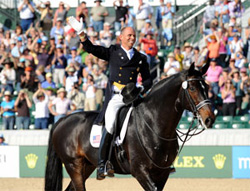[/caption]

October 7, 2010 — Next to show jumping (120 entries), the four-in-hand driving ranks at the Alltech FEI World Equestrian Games seem miniscule. There are only 26 starters from nine countries, though it is a highly competitive group including eight-time U.S. national champion Chester Weber, who owns world championships individual and team silver medals; Ijsbrand Chardon of the Netherlands, who has eight world championships, both individually and with the Dutch team, and British-based Boyd Exell of Australia, a three-time winner at the highly competitive Aachen show.
The cost of bringing five horses for a single team from Europe to the U.S., which has been quoted to me as $200,000, was discouraging for some, especially those who knew they didn’t have a chance to medal. The demands of driving this many horses are intense for one person, and the countries that have people who do it at the highest level are few. Unlike show jumping, this Euro-centric sport does not draw from Latin America, the Middle East or Asia.

All that being said, four-in-hand driving is an interesting sport, with rules organized by Prince Phillip of Great Britain along the same lines as three-day eventing.
Today and tomorrow were set aside for dressage. No, there’s no piaffe or passage; but plenty of extensions, halts, driving one-handed and extended trots in an impressive temporary stadium that is about a 10-minute walk from the main stadium. Saturday is the marathon, a test of endurance and speed in hazards that are not hazardous but rather, an opportunity to demonstrate expertise in control with tight turns. Sunday, before the WEG closing ceremonies, the drivers will finish their competition on a course of closely-spaced pairs of cones topped with delicately balanced balls that can quickly add to a competitor’s penalty total if they get dislodged.
The U.S. was off to a good start, as Chester tied with Ijsbrand for first place on 35.97 penalties. After his test, Chester took off his top hat and tie, relaxing as we talked about his performance, marred (at least as far as I could see) only by a bit of resistance in one rein-back, but buoyed by a lovely floating extended trot.

Theo Timmerman, the other Dutch driver who competed today, is third with 40.19 penalties, giving his country the early lead on 76.16 penalties (only two of three scores count for a team.) The U.S. is second with 87.94 and the Germans third with 103.4.
The other American who competed today, Jimmy Fairclough, was sixth behind Germany’s Christoph Sandmann (40.58) and Sweden’s Tomas Eriksson (50.30), both of whom certainly came into the competition with the possibility of winning it.
Jimmy, marked at 51.97 penalties, wasn’t 100 percent happy with his test.

Jimmy, by the way, is the third WEG contender backed by U.S. Equestrian Team President Jane Clark. She also sponsored dressage rider Katherine Bateson-Chandler with Nartan and show jumper Mario Deslauriers with Urico. Jane is waiting for her first medal here and may get it in driving.
There was a good number of spectators today, amazing for a lower-profile sport on an October Thursday. I expect many more for the marathon, though not as many as for the cross-country, since folks in the area know more about that because the Rolex Kentucky 4-star is an annual fixture here.
In assessing prospects for the marathon, Theo suggested that some of the hazards may be too easy. But combined with temperatures that will rise to 80 degrees during the afternoon and the up-and-down terrain of the Kentucky Horse Park, Theo may find the middle leg of the driving to be more of a challenge than he imagines at the moment.
“There’s nothing free here,” Chester warned.
“This is not like many shows we go to where the warm-up section is on hard roads or flat ground. Here it seems you’re always going up or down hill, pushing the horses up or supporting them as they go down,” he said, adding it will pay off for drivers if their horses have a lot of power left at the end of the marathon.
Tomorrow, the final member of the U.S. team, Tucker Johnson, will compete. Both Chester and I believe he can move into first place. He’s usually a star in dressage.

It was great to see Bill Long drive today. At age 65, he’s retiring from the big competitions after this. At one time, he was the USA’s top driver when he worked for Finn Caspersen, and he helped make a name for U.S. four-in-hand driving “back in the day,” as they say. He’s one of six Americans driving as an individual. I think this is the heyday of U.S. four-in-hand driving. The stimulus of having the WEG at home brought out a lot of contenders. After this, it’s back to Europe for the major events, so I expect the four-in-hand field here to shrink accordingly.
Tomorrow is going to be quite a day. We have the conclusion of the driving dressage and I hope to get to vaulting as well. In the late afternoon and evening, the top 30 show jumpers will vie to be among the final four who ride for the medals Saturday night.
We’ve been here for so long there were times it seemed as if the WEG would never end, but now we’re sensing the finish line. Those of us who have been here the whole time, whether media, volunteers or organizers, are exhausted, though spirits are high.
I’ll have another report tomorrow night to fill you in on everything.
Until then,

Visit EquiSearch.com’s World Equestrian Games headquarters for news, blogs, photo galleries and more!





